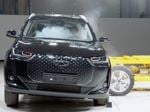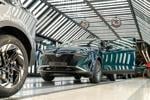There are two targets it has set for itself.
The first is to have a fuel cell which will run for 5,500 hours – the equivalent of driving between 116,000 kms and 240,000 kms depending on use.
The second is to get the cost down to the equivalent of $50 (£25.3) per kilowatt of power produced. “A small, mass produced petrol engine which we make in the millions costs $30 per kilowatt,” said Dr Lars Peter Thiesen, manager of GM Europe’s fuel cell deployment strategy.
“A big, sophisticated engine with direct injection costs $70 per kilowatt, so we’ve pitched the fuel cell midway between the two,” he said, speaking at a media briefing at the company’s test track near Frankfurt.
“I’m very optimistic we can get there – we’ve invested €1bn (£676m) since 1997 and fuel cells are the major part of our global R&D budget.”
Before then, GM will conduct what Dr Thiesen described as a “huge market test around the world” with both ordinary customers and business customers. This will involve having more than 100 hydrogen fuel cell vehicles running to create “a microcosm of car use.”
These will be fourth generation FCVs. The first will go into use in the USA later this year with the European vehicles ready for early 2008.
Until now GM has only built the number of FCVs it needs to learn enough for the next step.
Third generation FCVs are currently in use in an industry-wide experiment in Berlin, the Clean Energy Partnership. This also involves Ford, BMW and DaimlerChrysler with BP and Total providing the hydrogen. A second hydrogen filling station has just opened.
One of the major problems is the hydrogen refuelling infrastructure, said Dr Thiessen. Although fuel cells could be run on other energy sources, there is no point in using any fuel that isn’t itself zero emission.
The conversion efficiency of GM’s current fuel cell vehicles – the amount of energy extracted from the fuel that ends up powering the wheels – is 36 per cent, well ahead of diesel engines at 22 per cent. “We want to get to 40 per cent or about twice the efficiency of internal combustion engines,” said Dr Thiesen.












Login to comment
Comments
No comments have been made yet.